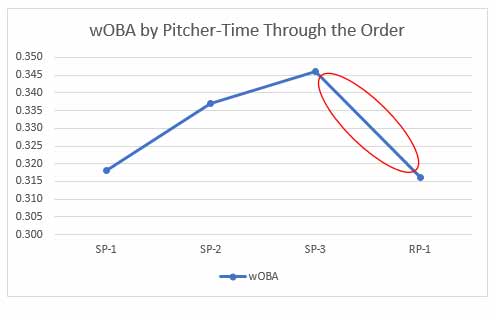It is no secret in baseball that starting pitchers have a shorter leash than ever before. Offense around the league has taken huge steps forward in recent years and managing games through pitching and the use of the bullpen has had to counter that. To understand the reasoning behind managers’ decisions with their pitching, we must dive into the data.
wOBA
Weighted On Base Average (wOBA) is one of the most talked about statistics in baseball because of its ability to weigh how the result of the at bat contributes to run scoring. In order from heavily weighted to least heavily weighted in the formula, it goes home run, triple, double, single, hit by pitch, and unintentional walk. When looking at wOBA against pitchers based on number of times through the order, it’s obvious why they are taken out earlier in games than what fans are used to. First time through the order hitters have a .318 wOBA, second time through they have a .337 wOBA, and third time through they have a .346 wOBA. Notice how most noticeable jump is the one between the first and second time through the order. The practicality in removing a starting pitcher after their first time through the order is tough to get on board with, considering the length of a major league season and the burden that would put on the bullpen. However, the practicality of removing the starting pitcher after the second time through the order may be rather wise. The increase of .028 points in wOBA could be too much and is easily negated by a pitching change; Hitters have a .316 wOBA against relief pitchers their first time through the order. The change is essentially like pitching to Jose Reyes (.316 wOBA and -0.6 WAR) instead of pitching to Robinson Cano (.345 wOBA and 3.4 WAR).

Who Can You Trust?
When constructing a pitching staff, each team hopes to identify one or two top of the line starters in their rotation. Over the course of the season they look for these players to get as close to 200 innings as they possibly can and their efficiency typically allows them to throw 6-7 innings of shutout ball on a nightly basis. What is not addressed enough is that regardless of the track record or hefty contracts attached to a player, they are not any more immune to the difficulty of pitching to a lineup the third time through the order any more than another starter in the rotation. Sure, there are Cy Young candidates who are, for the most part, outliers to these data sets, but even guys that are pinned as a team’s ace can’t fully overcome the third time through like most managers or fans think they can. Jake Odorizzi, who was just traded to the Twins as a bolster to their rotation, owned a .384 wOBA when facing hitters for a third time or more. Gerrit Cole, who was just traded to the Astros and solidified the staff as undoubtedly the best in baseball, owned a .367 wOBA when facing hitters for a third time or more. Even 2016 Cy Young winner Rick Porcello pitched to a .348 wOBA in the same situations. Regardless of track record or contract, there is no way of escaping such a glaring fate.
There’s no doubt that limiting starting pitchers to something close to two times through the order, or 18 batters, is a tough feat to complete over a 162 game season in terms of keeping an entire pitching staff healthy. What is evident is that keeping starters at that threshold is an important piece to keeping a team competitive in important games. It’s true that not every game is as important as another and that even the best teams lose more than 60 games annually, but when an entire season is on the line, in a postseason series, it’s difficult to trust a starting pitcher going more than two times through the order no matter their track record. After all, the average outing in the World Series was 18.9 batters faced per start compared to the 2017 League average of 23.6 batters per game.
Sources
“Fangraphs Leaderboards.” (2018) Fangraphs, Retrieved March 26, 2018.
About the Author
 Rory Houston is a Junior at Saint Joseph's University double majoring in Business Intelligence and Analytics & Sports Marketing, looking to pursue a career in baseball.
Rory Houston is a Junior at Saint Joseph's University double majoring in Business Intelligence and Analytics & Sports Marketing, looking to pursue a career in baseball.
